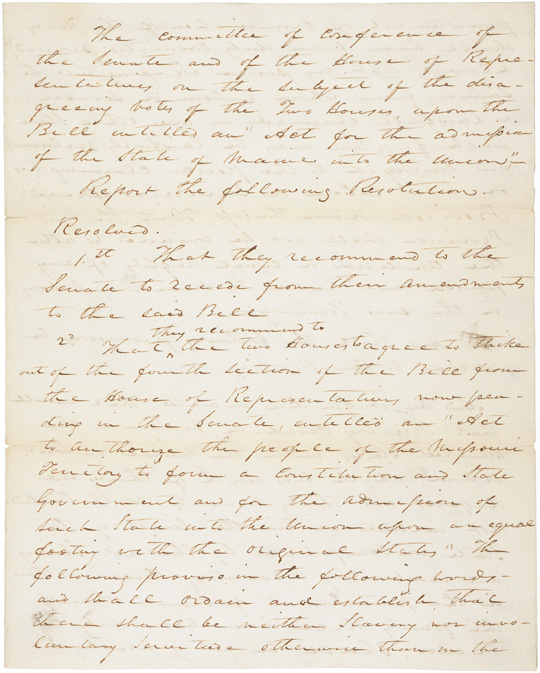Missouri Compromise was a plan agreed upon by the United States Congress in 1820 to settle the debate over slavery in the Louisiana Purchase area. The plan temporarily maintained the balance between free and slave states.

In 1818, the Territory of Missouri, which was part of the Louisiana Purchase, applied for admission to the Union. Slavery was legal in the Territory of Missouri, and about 10,000 enslaved Black people lived there. Most people expected Missouri to become a slave state. When the bill to admit Missouri to the Union was introduced, there were an equal number of free and slave states. Six of the original 13 states and five new states permitted slavery, while seven of the original states and four new states did not. This meant that the free states and the slave states each had 22 senators in the United States Senate. The admission of Missouri threatened to destroy this balance.
This balance had been temporarily upset a number of times, but it had always been easy to decide whether states east of the Mississippi River should be slave or free. The Mason-Dixon Line and the Ohio River formed a natural and well-understood boundary between the two sections. No such line had been drawn west of the Mississippi River. In addition, some parts of Missouri Territory lay to the north of the mouth of the Ohio River, while other parts of it lay to the south.
A heated debate broke out in Congress when Representative James Tallmadge of New York introduced an amendment to the bill enabling Missouri to become a state. Tallmadge proposed to prohibit the bringing of any more enslaved people into Missouri, and to grant freedom to the children of enslaved people born within the state after its admission. This proposal disturbed Southerners, who found cotton growing by means of slave labor increasingly profitable, and feared national legislation against slavery. Because the free states dominated the House of Representatives, the slave states felt they must keep the even balance in the Senate.
The Tallmadge Amendment passed the House, but the Senate defeated it. During the next session of Congress, Maine applied for admission to the Union. Missouri and Maine could then be accepted without upsetting the Senate’s balance between free and slave states, and the Missouri Compromise became possible.
The compromise admitted Maine as a free state and authorized Missouri to form a state constitution. A territory had to have an established constitution before it could become a state. The compromise also banned slavery from the Louisiana Purchase north of the southern boundary of Missouri, the line of 36° 30′ north latitude, except in the state of Missouri.
The people of Missouri believed they had the right to decide about slavery in their state. They wrote a constitution that allowed slavery and that restricted free Black citizens from entering the state.
Before Congress would admit Missouri, a second Missouri Compromise was necessary. Henry Clay, the speaker of the House, helped work out this agreement. It required the Missouri legislature not to deny Black citizens their constitutional rights. With this understanding, Missouri was admitted to the Union in 1821.
In 1848, Congress passed the Oregon Territory bill, which prohibited slavery in the area. President James K. Polk signed the bill because the Oregon Territory lay north of the Missouri Compromise line. Later proposals tried to extend the line by law across the continent to the Pacific Ocean. These efforts failed. The Missouri Compromise was repealed by the Kansas-Nebraska Act of 1854 (see Kansas-Nebraska Act).
